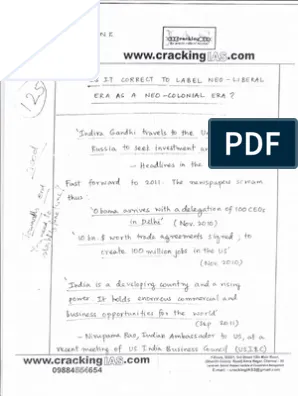- Home
- Prelims
- Mains
- Current Affairs
- Study Materials
- Test Series
How far was the Industrial Revolution in England responsible for the decline of handicrafts and cottage industries in India? (Answer in 250 words). (UPSC IAS Mains 2024 General Studies Paper – 1)
The Industrial Revolution in England, spanning from the mid-18th to the mid-19th century, played a significant role in the decline of handicrafts and cottage industries in India.
Technological Advancements
• The mechanization of production in England led to mass-produced goods at significantly lower costs.
• These goods, particularly textiles, were exported to India, creating fierce competition for local artisans.
• Indian handicrafts, unable to match the price and volume of machine-made products, began to lose market share.
Colonial Policies
• British colonial rule facilitated the influx of British goods into India.
• Policies were implemented that disadvantaged Indian industries:
– High tariffs on Indian goods exported to Britain
– Low tariffs on British goods imported to India
– Encouragement of raw material exports from India to feed British industries
Market Disruption
• Traditional patronage systems that supported Indian artisans were disrupted.
• Local markets were flooded with cheaper British goods, reducing demand for Indian handicrafts.
• The East India Company’s monopoly further stifled local production and trade.
Specific Industries Affected
• Textiles were hit hardest, with cities like Dacca and Murshidabad seeing severe declines in production.
• Other affected industries included metalwork, pottery, and leather goods.
Long-term Consequences
• De-industrialization of India, shifting from a producer to a raw material supplier.
• Loss of specialized skills and traditional knowledge.
• Widespread unemployment among artisans, leading to social and economic upheaval.
The effects Industrial Revolution in England fundamentally altered India’s economic landscape, leading to long-lasting changes in the country’s industrial and social structure.










 Latest News
Latest News
 General Studies
General Studies